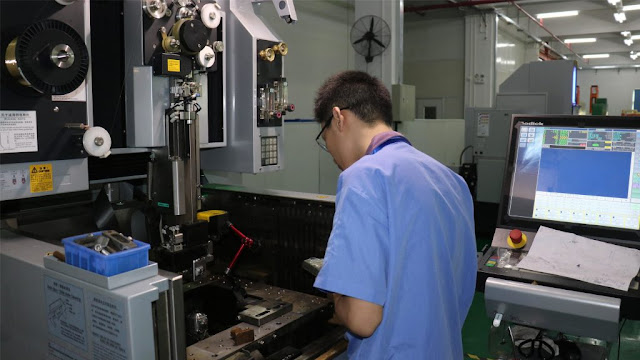Application of 3+2 CNC Machining in Mold Making Factory
Plastic injection mold manufacturers have long embraced simultaneous multiple-axis machining on machine tools with five or more axes, but more and more China injection mold makers have begun machining mold components on multiaxis platforms in the past few years, said Charlie Chan, engineering manager HS Mold & Die Co.,LTD
He mentioned, however, that the common approach for machining mold parts in houses is 3+2, or 5-axis positional machining. According to his estimate, about 80% to875% of the multi-axis work is performed via 3+2 rather than simultaneous when cutting up to five sides of a prismatic metal workpiece in one fixturing.
What is 3+2 CNC Machining
3+2 (5 axis) CNC machining, also called “positional five-axis machining”, is a technique whereby a three-axis milling program is executed with the cutting tool locked in a tilted position using the 5-axis machine’s two rotational axes, hence the name, 3+2 machining. During the machining process, the fourth and fifth axes are used to rotate the cutting tool in a fixed position rather than to manipulate the tool continuously. On a standard three-axis machine, the only part face that the CNC machine could cut with a cutting tool in its normal position is the horizontal face that faces directly at the spindle.
3+2 CNC Machining Advantages
Compared to conventional three-axis
machining, the main advantage of 3+2 CNC machining is the
reduction of setup time.
According to data from our mold making shop, we could save easily 20% to 25% in setup time because we don’t have to handle that part multiple times.”
Another big benefit of 3+2
CNC Machining is that it allows for the use of a shorter, more rigid cutting tool. With 3+2 machining, the spindle head can be lowered closer to the work piece
with the tool angled toward the part surface. This means that a good
surface finish and more accurate dimensional results can be achieved .This helps to improve part accuracy by being able to position
a work piece so that short, rigid cutting tools are applied, such as when
producing undercuts in mold cavities and steep wall inserts.
In addition, with 3+2 machining, we
can use standard, off-the-shelf tools
Rather than
using some custom, extra-long tool or holder and risk vibration, this
helps to save money easily by 10% to 15% in injection mold costs because there is no need to use special tools
For mold manufacturers in china, 3+2
Machining is an ideal option because they can use
more off-the-shelf, standard catalog tooling. They have the freedom to reach into my part at different
angles without using an
especially long tool or special to make that feature on that part.
Application of 3+2 CNC Machining
Where applicable, 3+2 machining will save time and improve operations. This technique is more and more popular with mold making company because it offers great convenience while deep cavities or inserts in complex plastic molds that would otherwise
have to be machined with long, slender tools or with tool extensions. Long,
slender tools increase the risk of deflection or chatter and tool extensions
can create clearance problems. Using 3+2 machining also allows undercuts in
cavities and steep walls on standing mold cores to be machined directly. This technique might reduce or eliminate
operations for electrical discharge machining (EDM).Relatively few parts are not
suitable for 3+2 machining, including complex components. 3+2 CNC Machining is usually used to machine below parts:
l deep cavities or inserts in complex plastic molds
l certain types of parts from the solid rather
than from a complex casting
l Drilling holes of metal parts at compound angles such as aluminum brake cylinders in a single setup
We are a China injection mold
maker and our CNC machining center has both 3+2 and full 5 axis machining
capability, capable of making prototypes and production parts
as fast as one
day. Reach out HS Mold and see how we
could benefit your next CNC rapid prototyping or low-volume
manufacturing project.




Comments
Post a Comment